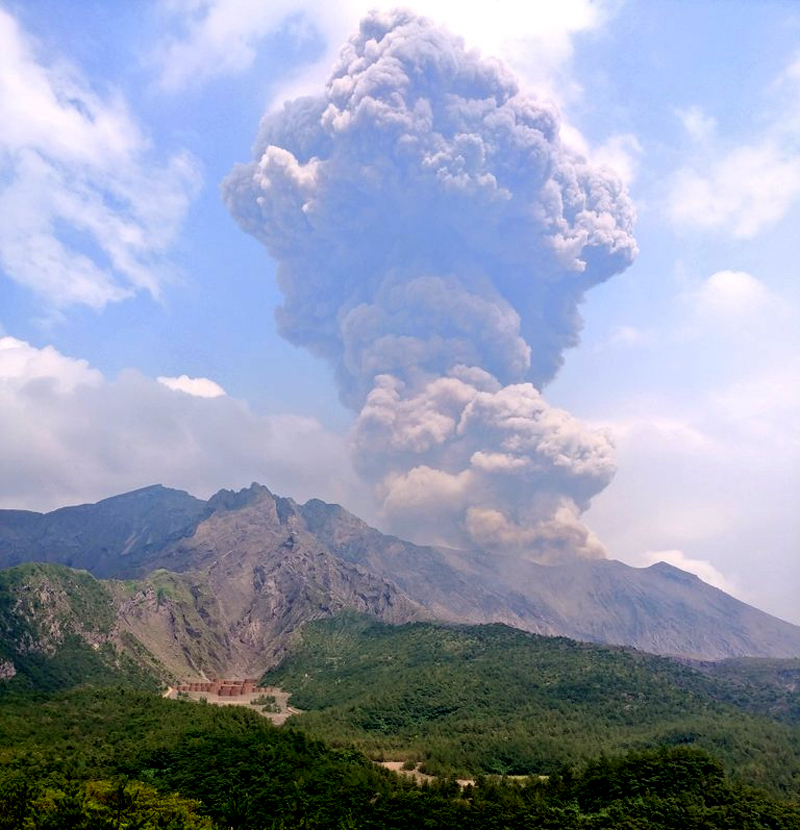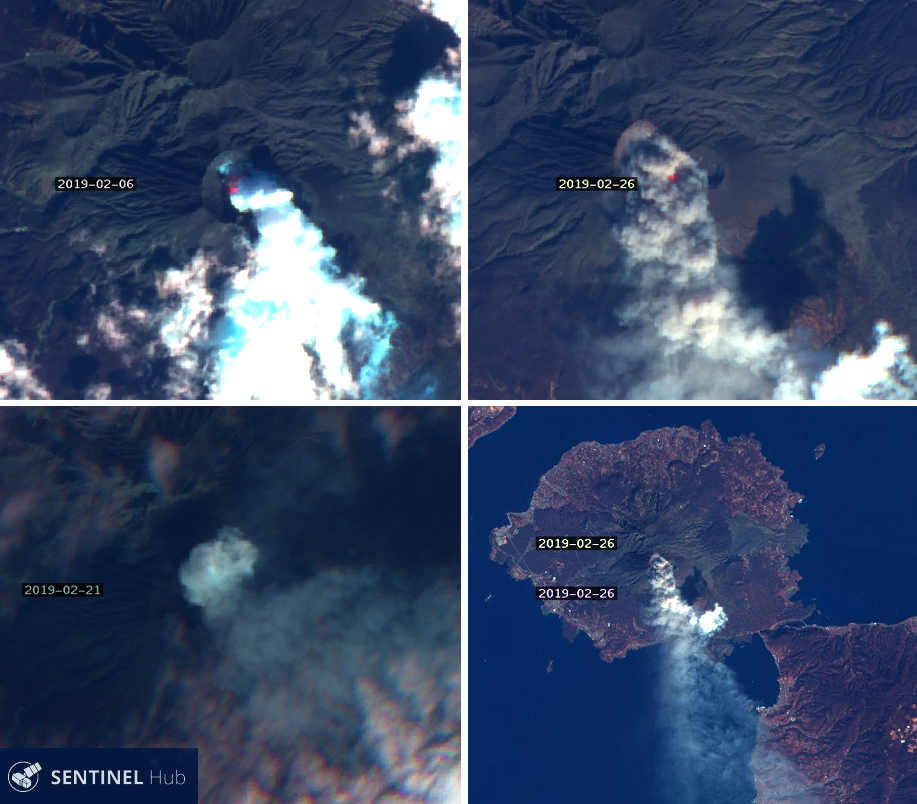Report on Aira (Japan) — July 2019
Bulletin of the Global Volcanism Network, vol. 44, no. 7 (July 2019)
Managing Editor: Edward Venzke.
Edited by A. Elizabeth Crafford.
Aira (Japan) Explosions with ejecta and ash plumes continue weekly during January-June 2019
Please cite this report as:
Global Volcanism Program, 2019. Report on Aira (Japan) (Crafford, A.E., and Venzke, E., eds.). Bulletin of the Global Volcanism Network, 44:7. Smithsonian Institution. https://doi.org/10.5479/si.GVP.BGVN201907-282080
Aira
Japan
31.5772°N, 130.6589°E; summit elev. 1117 m
All times are local (unless otherwise noted)
Sakurajima rises from Kagoshima Bay, which fills the Aira Caldera near the southern tip of Japan's Kyushu Island. Frequent explosive and occasional effusive activity has been ongoing for centuries. The Minamidake summit cone has been the location of persistent activity since 1955; the Showa crater on its E flank has also been intermittently active since 2006. Numerous explosions and ash-bearing emissions have been occurring each month at either Minamidake or Showa crater since the latest eruptive episode began in late March 2017. This report covers ongoing activity from January through June 2019; the Japan Meteorological Agency (JMA) provides regular reports on activity, and the Tokyo VAAC (Volcanic Ash Advisory Center) issues tens of reports each month about the frequent ash plumes.
From January to June 2019, ash plumes and explosions were usually reported multiple times each week. The quietest month was June with only five eruptive events; the most active was March with 29 (table 21). Ash plumes rose from a few hundred meters to 3,500 m above the summit during the period. Large blocks of incandescent ejecta traveled as far as 1,700 m from the Minamidake crater during explosions in February and April. All the activity originated in the Minamidake crater; the adjacent Showa crater only had a mild thermal anomaly and fumarole throughout the period. Satellite imagery identified thermal anomalies inside the Minamidake crater several times each month.
Table 21. Monthly summary of eruptive events recorded at Sakurajima's Minamidake crater in Aira caldera, January-June 2019. The number of events that were explosive in nature are in parentheses. No events were recorded at the Showa crater during this time. Data courtesy of JMA (January to June 2019 monthly reports).
| Month | Ash emissions (explosive) | Max. plume height above crater | Max. ejecta distance from crater |
| Jan 2019 | 8 (6) | 2.1 km | 1.1 km |
| Feb 2019 | 15 (11) | 2.3 km | 1.7 km |
| Mar 2019 | 29 (12) | 3.5 km | 1.3 km |
| Apr 2019 | 10 (5) | 2.2 km | 1.7 km |
| May 2019 | 15 (9) | 2.9 km | 1.3 km |
| Jun 2019 | 5 (2) | 2.2 km | 1.3 km |
There were eight eruptive events reported by JMA during January 2019 at the Minamidake summit crater of Sakurajima. They occurred on 3, 6, 7, 9, 17, and 19 January (figure 76). Ash plume heights ranged from 600 to 2,100 m above the summit. The largest explosion, on 9 January, generated an ash plume that rose 2,100 m above the summit crater and drifted E. In addition, incandescent ejecta was sent 800-1,100 m from the summit. Incandescence was visible at the summit on most clear nights. During an overflight on 18 January no significant changes were noted at the crater (figure 77). Infrared thermal imaging done on 29 January indicated a weak thermal anomaly in the vicinity of the Showa crater on the SE side of Minamidake crater. The Kagoshima Regional Meteorological Observatory (KRMO) (11 km WSW) recorded ashfall there during four days of the month. Satellite imagery indicated thermal anomalies inside Minamidake on 7 and 27 January (figure 77).
Activity increased during February 2019, with 15 eruptive events reported on days 1, 3, 7, 8, 10, 13, 14, 17, 22, 24, and 27. Ash plume heights ranged from 600-2,300 m above the summit, and ejecta was reported 300 to 1,700 m from the crater in various events (figure 78). KRMO reported two days of ashfall during February. Satellite imagery identified thermal anomalies at the crater on 6 and 26 February, and ash plumes on 21 and 26 February (figure 79).
The number of eruptive events continued to increase during March 2019; there were 29 events reported on numerous days (figures 80 and 81). An explosion on 14 March produced an ash plume that rose 3,500 m above the summit and drifted E. It also produced ejecta that landed 800-1,100 m from the crater. During an overflight on 26 March a fumarole was the only activity in Showa crater. KRMO reported 14 days of ashfall during the month. Satellite imagery identified an ash plume on 13 March and a thermal anomaly on 18 March (figure 82).
 |
Figure 80. A large ash emission from Sakurajima volcano at Aira was photographed by a tourist on the W flank and posted on 1 March 2019. Courtesy of Kratü. |
A decline in activity to only ten eruptive events on days 7, 13, 17, 22, and 25 was reported by JMA for April 2019. An explosion on 7 April sent ejecta up to 1,700 m from the crater. Another explosion on 13 April produced an ash plume that rose 2,200 m above the summit. Most of the eruptive events at Sakurajima last for less than 30 minutes; on 22 April two events lasted for almost an hour each producing ash plumes that rose 1,400 m above the summit. Ashfall at KRMO was reported during seven days in April. Two distinct thermal anomalies were visible inside the Minamidake crater on both 12 and 27 April (figure 83).
There were 15 eruptive events during May 2019. An event that lasted for two hours on 12 May produced an ash plume that rose 2,900 m from the summit and drifted NE (figure 84). The Meteorological Observatory reported 14 days with ashfall during the month. Two thermal anomalies were present in satellite imagery in the Minamidake crater on both 17 and 22 May.
During June 2019 five eruptive events were reported, on 11, 13, and 24 June; the event on 11 June lasted for almost two hours, sent ash 2,200 m above the summit, and produced ejecta that landed up to 1,100 m from the crater (figure 85). Five days of ashfall were reported by KRMO.
 |
Figure 85. A large ash plume on 11 June 2019 rose 2,200 m above the summit of Sakurajima volcano at Aira. Courtesy of Aone Wakatsuki. |
Geological Summary. The Aira caldera in the northern half of Kagoshima Bay contains the post-caldera Sakurajima volcano, one of Japan's most active. Eruption of the voluminous Ito pyroclastic flow accompanied formation of the 17 x 23 km caldera about 22,000 years ago. The smaller Wakamiko caldera was formed during the early Holocene in the NE corner of the caldera, along with several post-caldera cones. The construction of Sakurajima began about 13,000 years ago on the southern rim and built an island that was joined to the Osumi Peninsula during the major explosive and effusive eruption of 1914. Activity at the Kitadake summit cone ended about 4,850 years ago, after which eruptions took place at Minamidake. Frequent eruptions since the 8th century have deposited ash on the city of Kagoshima, located across Kagoshima Bay only 8 km from the summit. The largest recorded eruption took place during 1471-76.
Information Contacts: Japan Meteorological Agency (JMA), Otemachi, 1-3-4, Chiyoda-ku Tokyo 100-8122, Japan (URL: http://www.jma.go.jp/jma/indexe.html); Tokyo Volcanic Ash Advisory Center (VAAC), 1-3-4 Otemachi, Chiyoda-ku, Tokyo, Japan (URL: http://ds.data.jma.go.jp/svd/vaac/data/); Sentinel Hub Playground (URL: https://www.sentinel-hub.com/explore/sentinel-playground); Mike Day, Minnesota, Twitter (URL: https://twitter.com/MikeDaySMM, photo at https://twitter.com/MikeDaySMM/status/1083489400451989505/photo/1); Kratü, Twitter (URL: https://twitter.com/TalesOfKratue, photo at https://twitter.com/TalesOfKratue/status/1101469595414589441/photo/1); Tim Board, Japan, Twitter (URL: https://twitter.com/Hawkworld_, photo at https://twitter.com/Hawkworld_/status/1107789108754038789); Aone Wakatsuke, Twitter (URL: https://twitter.com/AoneWakatsuki, photo at https://twitter.com/AoneWakatsuki/status/1138420031258210305/photo/3).









